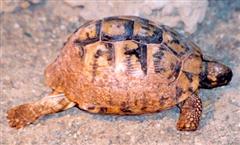Hermann's Tortoise
Hermanns Tortoise Scientific Name: Testudo hermanni
Tue, 15th July, 2025 - 10:52 pm GMT
Sponsor Ads:

Alternative Name
Hermanns Tortoise Scientific Name: Testudo hermanniBasic Info
Hermann's Tortoises are moderately sized, with the carapace (top of shell) length averaging around 8 inches. Their upper jaw is hooked, like many tortoises, and their snout does not protrude. The Hermann's Tortoise's shell is yellow, orange, olive, or dark brown in color and somewhat domed on top. Specimens with lighter colored shells may have dark markings. The underside of the shell, or the plastron, is usually black or dark brown, often with a yellow border and seam. The shell often develops a wavy rim as the animal matures. Some, but not all, Hermann's Tortoises have a divided supracaudal scute. The tail of the Hermann's Tortoises has a "claw" at the end. Hermann's Tortoise does not have bumps or spurs on its rear thighs. Their feet have five claws.
Health
If kept in a suitable climate, caring for Hermann's Tortoise is not difficult, however, the right environmental conditions are essential for successful long-term care of this species. In proper climates, Hermann's Tortoises should be kept outdoors. Breeding Male Hermann's Tortoises may be quite aggressive and will often ram other males to defend their territory. They will also ram females and become even more aggressive during mating season. Hermann's Tortoises usually breed in spring and summer. After mounting the female, the male usually becomes very vocal. His vocalizations are quite high and squeaky. The female lays clutches of between 2 and 12 eggs in small nests, which they usually build on slopes. The nests are usually 3 or 4 inches (7 - 9cm) deep, and the eggs usually take between 90 and 120 days to hatch.Habitat
They prefer regions where there is lots of vegetation, but they try to remain in arid areas.Behavior
The Hermann's Tortoise is a small tortoise native to Europe. Hermann's Tortoises are fairly common in captivity, although captive Hermann's Tortoises do not do well in climates unlike their native habitat. If the conditions are not suitable, they have very high mortality rates. Found in Europe, Hermann's Tortoise usually makes its home in Mediterranean oak forests. They can also be found in dry meadows and rocky or scrub hills. Hermann's Tortoise is primarily herbivorous, meaning they eat mostly plant matter. Some of their favorite foods include grass and clovers. They also eat fruit and flowers. When plant matter is not available, however, they will eat snails, carrion, slugs, and animal feces. Hermann's Tortoises should never be fed legumes or other vegetables high in protein. As is the case with all tortoises, if your weather conditions permit, an outdoor living arrangement is better for your tortoise. Although Hermann's Tortoise prefers dry areas to humid ones, they will soak in water when it is available. Male Hermann's Tortoises are often aggressive to one another and to other animals. In parts of the Hermann's Tortoises range where temperatures drop below freezing in the winter, they will brumate between October and April. When not brumating, Hermann's Tortoise is a very active tortoise and is usually very curious and intelligent.Origin
EuropeHistory
Hermann's Tortoise can be found in southern Europe. They are native to France, Italy, Greece, Spain, Bulgaria, Turkey, and various Mediterranean islands. Recently, thousands of Hermann's Tortoises were being exported from their native lands to Britain and the United States as pets. Hermann's Tortoises can only survive in the Mediterranean climates they are native to and most specimens died after less than a year in captivity. In the 1980s and 90s, the European Economic Community banned the trade of Hermann's Tortoises and their numbers in the wild began to increase once more. The destruction and development of their natural habitat is once again threatening the existence of Hermann's Tortoise.Common Foods
In the wild they eat mostly weeds that are high in fiber and low in fat and protein. Hermann's Tortoises eat a lot, if given the opportunity. Unless kept outside on a natural diet their consumption has to be watched very carefully.Sponsor Ads:
The only meaning in life is what we (all conscious beings, not just humans) give it. -- demona
Hermann's Tortoise
Coded by: BGID® | ALL RIGHTS RESERVED Copyright © 2000-2025
Disclaimer | Privacy | Report Errors / Contact | Credits








 Preparing For China. China is growing their military. China Military Technology - can it keep up with the US?
Preparing For China. China is growing their military. China Military Technology - can it keep up with the US?  versus
versus 

 versus
versus 
 This Thread is about the North Korean Military itself - the kind of army, navy, and air force they have.
This Thread is about the North Korean Military itself - the kind of army, navy, and air force they have. 
 versus
versus 
 versus
versus  versus
versus